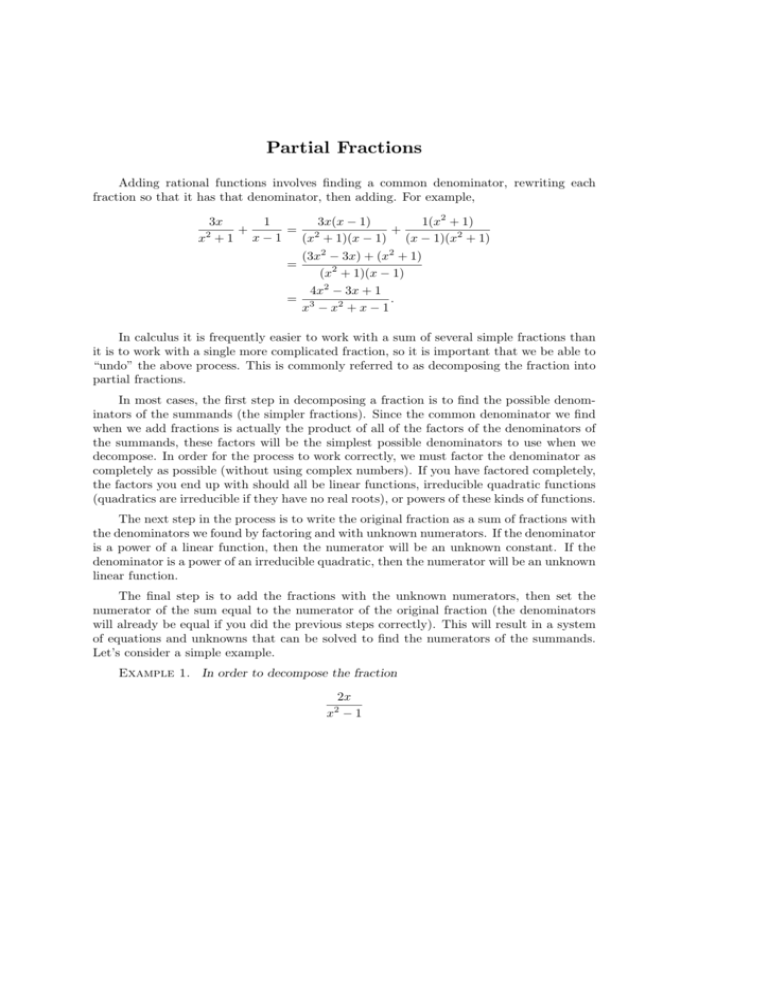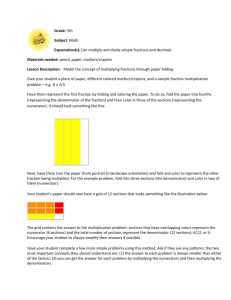Partial Fractions
advertisement

Partial Fractions Adding rational functions involves finding a common denominator, rewriting each fraction so that it has that denominator, then adding. For example, 3x 3x(x − 1) 1 1(x2 + 1) + = + x2 + 1 x − 1 (x2 + 1)(x − 1) (x − 1)(x2 + 1) (3x2 − 3x) + (x2 + 1) = (x2 + 1)(x − 1) = 4x2 − 3x + 1 . x3 − x2 + x − 1 In calculus it is frequently easier to work with a sum of several simple fractions than it is to work with a single more complicated fraction, so it is important that we be able to “undo” the above process. This is commonly referred to as decomposing the fraction into partial fractions. In most cases, the first step in decomposing a fraction is to find the possible denominators of the summands (the simpler fractions). Since the common denominator we find when we add fractions is actually the product of all of the factors of the denominators of the summands, these factors will be the simplest possible denominators to use when we decompose. In order for the process to work correctly, we must factor the denominator as completely as possible (without using complex numbers). If you have factored completely, the factors you end up with should all be linear functions, irreducible quadratic functions (quadratics are irreducible if they have no real roots), or powers of these kinds of functions. The next step in the process is to write the original fraction as a sum of fractions with the denominators we found by factoring and with unknown numerators. If the denominator is a power of a linear function, then the numerator will be an unknown constant. If the denominator is a power of an irreducible quadratic, then the numerator will be an unknown linear function. The final step is to add the fractions with the unknown numerators, then set the numerator of the sum equal to the numerator of the original fraction (the denominators will already be equal if you did the previous steps correctly). This will result in a system of equations and unknowns that can be solved to find the numerators of the summands. Let’s consider a simple example. Example 1. In order to decompose the fraction 2x x2 − 1 2 you would first factor the denominator x2 − 1 = (x + 1)(x − 1). Since the factors of the denominator are linear, the numerators of our partial fractions will be constants. Our goal then is to find constants A and B so that (∗) 2x A B = + . x+1 x−1 x −1 2 If we were to add the partial fractions on the right side of this equation, we would get A B A(x − 1) + B(x + 1) + = x+1 x−1 (x + 1)(x − 1) Ax − A + Bx + B = x2 − 1 (A + B)x + (B − A) . = x2 − 1 Since this is supposed to equal the original fraction, we want to find A and B so that 2x (A + B)x + (B − A) = . 2 x −1 x2 − 1 These fractions have the same denominators, so they will be equal exactly when their numerators are equal. In other words, we want 2x = (A + B)x + (B − A). Setting like terms equal and ignoring the powers of x, we obtain the following system of two equations and two unknowns: A+B =2 −A + B = 0 Next use whatever method seems simplest to solve this system. You should end up with A = 1 and B = 1. Finally, plug these into (∗) to obtain 2x 1 1 = + . x+1 x−1 x −1 2 You can check your work by adding the fractions we obtained to make sure that the sum is as desired. There are two things that you must watch out for that didn’t occur in our simple example above. The first is that the above procedure only works if the degree of the numerator is less than the degree of the denominator in the original fraction. If this is not 3 the case, then you will have to use polynomial division to rewrite the rational function as the sum of a polynomial and a rational function before you begin. The second thing to be careful of concerns the potential denominators of the partial fractions. When your factors of the original denominator include a power of a linear or quadratic function, you must remember that all positive integer powers of the function less than that power are also factors of the denominator, even if they didn’t show up explicitly. For example, the factors of (x − 1)(x + 3)3 are (x − 1), (x + 3)3 , (x + 3)2 , and (x + 3). Here’s a more typical example. Make sure that you pay attention to both of the issues mentioned above as you work through it. 5 4 3 2 Example 2. Decompose the fraction x −42x +36x −26x + 5x − 2 . x − 2x + 2x − 2x + 1 First note that the degree of the numerator is greater than the degree of the denominator. As noted above, we use polynomial division to rewrite the fraction. When you do so you should obtain (∗) x5 − 2x4 + 6x3 − 6x2 + 5x − 2 4x3 − 4x2 + 4x − 2 = x + . x4 − 2x3 + 2x2 − 2x + 1 x4 − 2x3 + 2x2 − 2x + 1 We now use the procedure above to rewrite the remaining fraction in (∗). First factor the denominator as completely as possible, it will be helpful to notice that 1 is a root of the denominator: x4 − 2x3 + 2x2 − 2x + 1 = (x − 1)(x3 − x2 + x − 1) = (x − 1)2 (x2 + 1) Now we can see that the denominators for our partial fractions are (x2 + 1), (x − 1)2 , and (x − 1). Remember that x − 1 is a factor, even though it doesn’t appear explicitly. Placing unknown constants in the numerator when the denominator is a power of a linear function and unknown linear functions in the numerator when the denominator is a power of an irreducible quadratic, we obtain (∗∗) 4x3 − 4x2 + 4x − 2 Ax + B C D = 2 + 4 3 2 2 + x − 1. x − 2x + 2x − 2x + 1 x +1 (x − 1) Next add the fractions on the right to obtain Ax + B C D + 2 2 + x−1 = x +1 (x − 1) (Ax + B)(x − 1)2 + C(x2 + 1) + D(x2 + 1)(x − 1) = (x2 + 1)(x − 1)2 4 Ax3 − 2Ax2 + Ax + Bx2 − 2Bx + B + Cx2 + C + Dx3 − Dx2 + Dx − D = x4 − 2x3 + 2x2 − 2x + 1 (A + D)x3 + (−2A + B + C − D)x2 + (A − 2B + D)x + (B + C − D) x4 − 2x3 + 2x2 − 2x + 1 Setting the numerator equal to the numerator of the fraction on the left side of (∗∗) and collecting like terms, we obtain the following system: A −2A +B A −2B B +C +C +D −D +D −D =4 = −4 =4 = −2 Solving the system above yields A = 1, B = 0, C = 1, and D = 3. We can plug these values into (∗∗) to obtain 4x3 − 4x2 + 4x − 2 x 1 3 = 2 + 4 3 2 2 + x − 1. x − 2x + 2x − 2x + 1 x + 1 (x − 1) Remember though that doesn’t complete the problem. We must now insert this into (∗) to obtain our final result: x5 − 2x4 + 6x3 − 6x2 + 5x − 2 x 1 3 = x + + + x−1 x4 − 2x3 + 2x2 − 2x + 1 x2 + 1 (x − 1)2 Problems: Decompose each of the following fractions. 1. 5x + 7 x2 + 2x − 3 −1 2. 3x x2 − x 2 +1 3. 5x − 2x 3 x 3 2 4. 2x 4− x +2 3x + 1 x + 2x + 1 2 5. 7x −4 16x + 36 x − 16 4 3 2 6. 4x 6+ 7x 4 + 4x2 − 7x x +x −x −1 4 3 2 7. x + x 3 + 2x + 1 x +x 4 3 − 2x2 + 4 8. 3x + 6x 3 x + 2x2 2 9. − x 2− 4x + 3 x −3 10. 4x x4 + 4 Hint: (−1 + i)4 = −4 5 Solutions 2 + 3 1. x + 3 x−1 5− 2 + 1 3. x x2 x3 3 + 1 5. 2x2 − 1 − x + 2 x−2 x +4 7. x + 1 − 9. −1 − 1 +1 x2 + 1 x 2√ − 2√ x+ 3 x− 3






